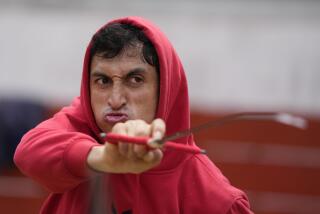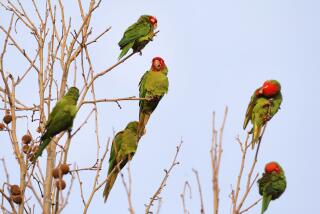The Bird Men of Afghanistan
KABUL, Afghanistan — KABUL, Afghanistan -- There are many tricks and almost as many rules in the ancient Afghan sport of partridge fighting.
It takes a year to raise a bird that will fight perhaps nine or 10 times in its life if it’s a winner, and even fewer if it loses. So the bird men of Kabul do whatever they can to give their own partridge--or kawk, in Farsi--an edge.
The night before a fight, some feed the bird a scorpion with the sting removed and just enough residual poison to anesthetize the bird to pain and fear. Others use a peck of opium to do the same. Both are allowed under the rules.
Then there are illegal tricks: sprinkling a bird’s neck feathers--the target area for attack--with alcohol, chili, pepper or bitter walnut leaves to put the other partridge off.
Spring has brought the return of partridge fighting, perhaps Kabul’s favorite gambling sport--and one that usually ends with one bird running away before blood is drawn.
Afghans have a keen sense of rivalry and competition, as 23 years of war suggests. Each Friday in this capital city and elsewhere, they stage partridge fights, cockfights, dogfights, even kamikaze kite fights and boiled-egg fights, all banned under the Taliban.
The bird men come out at the first soft light bearing bright cloth-covered domes of scarlet, green and blue that conceal wooden hooped cages with the fighting birds. The top birds are worth $500, a fortune in this shattered country. Hundreds gather in a ring for the first fight of the morning.
Mohammad Afzal, 70, is a fanatic, bouncing up and down in the front row, yelling out odds to other gamblers, putting money on one fighting partridge, then laying more money the other way. He got involved in partridge fighting when he was 20.
“Sometimes I win 3 or 4 million afghanis [$90 to $120]. Sometimes I lose that much,” he says with a shrug, unsure whether he has been an overall winner or loser in his life. He says that he was bored senseless in the early months of the Taliban rule because of the ban on fights but that soon they were organized secretly in houses and yards.
To an outsider, the competition looks almost comical, as the birds leap high into the air as if surprised, head-butt each other, run away and lock into a low, hunched stalemate.
With their smoky gray plumage and black barred wings, they look at first as mild as Christmas card partridges in a pear tree. But up close, their red-rimmed eyes and razor-sharp beaks give them a fierce aura.
Before the fight, owners sharpen their birds’ beaks with a knife and trim their claws with a nail-cutter so they don’t split. In the fights, the partridges peck each other with reasonable vigor, but blood is very rarely shed.
The welfare of the birds seems uppermost in the minds of the referees-cum-cage-carriers, who don’t allow the partridges to get exhausted, weak or overcome. They prowl around the fighting birds and at any sign of tiredness drop a cage over each bird until it’s rested.
Two bird-fanners are summoned to vigorously flap pieces of material to cool and calm the birds at each break. An elderly man has the job of watering the arena to keep the dust down.
The frequent intervals give the gamblers time to up their odds.
At times a referee picks up a bird and appears to kiss it. In fact, with his hands occupied holding the bird, he is picking a feather off the bird’s beak with his teeth.
Some matches are over in minutes, when one bird takes fright and runs off, refusing to fight. Most continue up to half an hour, but some fights can last as long as two hours.
No one could be a better guide through the maze of rules than Abdul Ghani, 45, partridge expert.
A week before the fight, the birds are weighed and the owners, or bird syndicates, put down an advance of $200 to $400 to fight. If the bird is injured before the fight or is ill, the owner either fights it or loses the deposit.
“If the two birds are fighting and one loses its nail or beak, the owner pays half the money because his partridge has not really lost. It faced an accident and was only half-defeated,” explains the gray-bearded Ghani, who knows everyone on the partridge-fighting circuit.
“It’s very difficult to train a bird. You have to take it high into the mountains to run like a sportsman, so that it develops its lung capacity,” he says, adding that this is done twice daily except for Tuesday, when partridges are usually given damp soil to play in.
After each fight, the birds get a special but unpleasant medicinal treatment that owners swear helps to ease the exhaustion of the fighting birds.
“You take some pomegranate skin and turmeric and put it on the bird and roll it tightly in a piece of cloth covering everything except its head. Then you leave it until the partridge feels it can’t breathe. When it is gasping and about to die from shortage of breath, you take the cloth away,” Ghani says. “For one or two nights it’s insensible. Then after two or three weeks, they can begin practice fighting, so they will be ready to fight again.”
The best ages to fight a partridge are between 3 and 6. They fight perhaps three times each spring. More often than that, and their livers might burst from the stress of the fights, Ghani warns.
After a bird loses, it usually gets spooked and isn’t fit to fight for a year.
“This business doesn’t bring any money,” Ghani, who owns two birds, says glumly. “It’s fate--it’s a gamble.”
Whether Ghani makes more money gambling on the birds than he says, he, like most of the crowd, is clearly carried away by the thrill of the sport. His eyes light up as he launches into zesty descriptions of its intricacies, and he eyes a newcomer with a smile at any sign of appreciation of the game.
Perhaps what makes partridge fighting so addictive is the unpredictability, even as the match is underway. A smaller bird might appear to be losing, when suddenly the larger bird might turn tail and run, for no apparent reason. So gamblers constantly yell out new bets as the match unfolds.
With his beady eyes and beaky nose, Qaladar, 80, bears a passing resemblance to the birds to which he has devoted his life. Like many Afghans, he goes by one name.
He began fighting birds at 15, continued secretly through the Taliban era, and now owns four partridges.
“We never fight without a bet,” he says, cackling. “All that trouble for nothing? Never!
“My birds win, by God’s grace. My beard is white. I am very experienced in this game.”
His most painful moment came when the Taliban raided a clandestine fight in which he had entered an excellent partridge. He and the other owners were forced to flee, abandoning their birds.
“It was all a Taliban plot to get my partridge and another man’s partridge because they knew they were the best birds,” he recalls.
At the ragged edges of the partridge-fighting crowd, small boys sell red boiled eggs for fights. After carefully testing his egg for strength by hitting it against his front teeth, a competitor knocks an end of his egg against an opponent’s end. The one with the cracked egg is the loser.
The aim, Afghan egg experts say, is to hit the opponent’s egg slightly off center. Anyone who so much as casts an interested glance at the baskets of eggs will immediately be surrounded by small boys pleading to fight eggs. Friday afternoons, men and children gather to fight kites, sailing bright paper ones high in the air, then attacking with a sawing motion of the string to slash an enemy kite free. Teams of boys run around bearing long sticks with barbed-wire hooks attached, designed to rescue stray kites from trees.
But in the absence of partridges, dogs, eggs or kites, Afghans still can’t resist a competition. A hand grabs a pile of sugared almonds, and a new challenge is shouted forth: odd or even?
The participants count the nuts to find the winner, and then share them, grinning from ear to ear.
More to Read
Sign up for Essential California
The most important California stories and recommendations in your inbox every morning.
You may occasionally receive promotional content from the Los Angeles Times.










